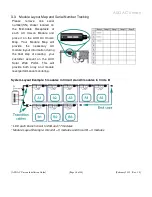
AUO AC Unison
[AUO AC Unison Installation Guide]
[Page 28 of 44]
[February 2012 Rev. 1.0]
-
Do not drop the AC Unison module or allow objects to fall on the AC Unison module.
-
Always wear protective head gear, insulating gloves and safety shoes (with rubber soles).
-
Due to the risk of electrical shock, do not perform any work if the terminals of the AC Unison module are wet.
-
Do not wear metallic jewelry which may conduct electricity and enable electric shock during installation.
-
Do not touch the junction box and the end of the output cables (connectors) with bare hands during installation or under
sunlight, regardless of whether the AC Unison module is connected to or disconnected from the system.
-
Do not unplug a connector if the system circuit is connected to an operating load.
-
Do not damage the back sheet of AC Unison modules when fastening the AC Unison modules to a support by bolts.
-
Do not damage the surrounding AC Unison modules or mounting structure when replacing an AC Unison module.
-
Use UV resistant materials, wire management hardware to secure cables. Drooping cables may cause various problems,
such as electricity leakage.
-
When AC Unison modules are installed on roofs or any other structures above ground, appropriate safety practices should
be followed and appropriate safety equipment should be used in order to avoid possible safety hazards.
-
Make sure flammable gases are not generated or present near the installation site.
Grounding and Bonding the AC Unison Cables
The AC cable attached to the micro-inverter and all cables are fully insulated and contain an equipment grounding conductor
(EGC). The full ground path from the transition cable to the module frame follows:
-
The transition cable's green conductor is connected to the EGC from the utility dedicated branch circuit.
-
All plugs have ground pins that are longer than the circuit pins. This extra length ensures the ground is the first to make
contact when connecting modules and the last to break contact when disconnecting modules.
-
The AC ground wire inside the micro-inverter makes a bolted termination to the micro-inverter chassis and is
environmentally sealed.
-
The micro-inverter chassis is bonded at the factory to the module frame with stainless steel hardware to provide ground
continuity to the AC Unison module frame.
The AC cable grounding path has been tested by a NRTL. Before an AC Unison module assembly can be labeled with the
NRTL certification mark and shipped from an authorized and inspected factory, each assembly must pass a ground continuity
check to verify electrical continuity from the AC cord ground pin to the AC Unison module frame. The AC cable provides
equipment grounding for the AC Unison module only. It is the installer's responsibility to ensure that any metallic parts in
contact with the module (i.e. mounting systems) are provided with a means of equipment grounding according to the
manufacturer’s instructions and local code.
Because the DC power is internal to the module, a grounding electrode conductor (GEC) is not required. Because the AC
Unison modules are connected in a “daisy chain” fashion, disconnecting one module from within the string removes power and
ground from subsequent modules in the string. Extreme care should be taken to ensure that no other energized sources are
adjacent to these ungrounded modules, or auxiliary grounding methods must be provided. A best practice for all solar module
installers, especially those in areas with frequent lightning (e.g. greater than 8 lightning strikes per square mile per year), is to
secure each module to the rack using grounding hardware that has been certified to meet requirements for grounding systems.
Connect the entire grounded structure to a grounding electrode system using a dedicated, suitably sized, copper conductor.
Lightning protection for electronic equipment in the home is often accomplished using rapid response SOV’s or MOV’s. These
devices are typically installed at a sub-panel or main service entrance panel where the AC Unison module system has been
connected. Lightning arrestors handle large surges from nearby lightning strikes and surge capacitors control surges that are
too fast or too light for a lightning arrestor to function. Although complete lightning protection systems from companies such as
Содержание AC UNISON
Страница 7: ...AUO AC Unison AUO AC Unison Installation Guide Page 6 of 44 February 2012 Rev 1 0 ...
Страница 10: ...AUO AC Unison AUO AC Unison Installation Guide Page 9 of 44 February 2012 Rev 1 0 ...
Страница 11: ...AUO AC Unison AUO AC Unison Installation Guide Page 10 of 44 February 2012 Rev 1 0 ...
Страница 12: ...AUO AC Unison AUO AC Unison Installation Guide Page 11 of 44 February 2012 Rev 1 0 ...
Страница 39: ...AUO AC Unison AUO AC Unison Installation Guide Page 38 of 44 February 2012 Rev 1 0 ...
















































